If you travel on the Berlin S-Bahn ring, you will come to the Messe Nord station. This is a busy place, especially during trade fairs, and from here you can get to the Messezentrum Berlin. But not only that. Here is also the ICC Berlin, the Berlin Radio Tower, the House of Radio and not far away is the Theodor-Heuss-Platz.
During a short walk you pass a wide variety of buildings and places with lots of Berlin history.
ICC – International Congress Center Berlin
In 1979, the ICC Berlin opened in Berlin. At that time it was one of the largest convention centers in the world.
For us Berliners, the “spaceship,” the “Noah’s Ark,” the “Battleship Charlottenburg” or even the “aluminum monster” with its silver-gray aluminum facade has always been a building with a controversial factor. Some liked the futuristic building, others said it would spoil the cityscape.

From an architectural point of view, the ICC is one of the most important buildings of the post-war period and, at the equivalent of 1.07 million euros, it was also one of the most expensive buildings in West Berlin. The building is 313 meters long, 89 meters wide and 40 meters high and stands like a block directly at the city highway and the exhibition halls. Yes, and really beautiful, I think, the ICC is not.

The International Congress Center was built when it was realized that the existing capacities of the congress rooms in the Berlin Congress Hall (Pregnant Oyster) in Tiergarten were no longer sufficient and also with the idea of expanding West Berlin as a congress location.
80 halls and rooms with a maximum capacity of 5000 seats were built. Numerous events were held here.
For example, I experienced my very first concert here. With a friend and her mother, we stood in the rather narrow rows of seats in a hall and tried to dance to the music of Shakin Stevens. Here one noticed that the rooms were actually not suitable for concerts. The chairs in the meeting rooms did have an interpreter function and microphones, but were geared toward meetings, not concerts. What I can still remember was the impressive entrance hall, from which a then innovative wayfinding system led to the rooms.
The last major event held here was the Daimler Annual General Meeting in 2014. After that, the building was closed.
Today, the technology in the building is outdated. The operator, Messe Berlin, is no longer interested in its continued use. The operating costs exceed the income from events.
There was a plan to demolish the building, but it was rejected by parts of Berlin politics.

In 2015, more than 500 refugees were temporarily housed in the ICC, after which it was used as a central contact point for asylum seekers.
In September 2019, the International Congress Center was declared a listed building. I do not know whether there is now a concept for its further use. The building is currently empty.
The ICC has already been used several times as a film location. For example, the crime thriller The International was shot in the main hall.
Underpass Messedamm/Masurenallee
The intersection where the ICC is located is one of the intersections that I don’t like as a driver. This is not so much because of the traffic routing, but rather because of the pedestrians.
There are no pedestrian lights here, but an underpass. Unfortunately, it often seems too much to ask to use one of the entrances, people just run across the street.

In doing so, you miss a really interesting place. The passenger underpass is tiled in orange and is quite spacious. Numerous films have been shot here: The Bourne Ultimatum, Who’s Hanna, The Tribute to Panem (Mockingjay Part 2), The First Avenger (Civil War), and Atomic Blonde. Every time I walk through here, I have the scene in my head where Katniss runs through this passage in Tribute to Panem. I would have loved to have watched the filming of that.
If you then come back to daylight on the other side of the underpass, you stand in front of the Messe Berlin exhibition hall and the Berlin Radio Tower.
Funkturm Berlin
When I left the GDR with my parents after a seemingly endless car ride over the transit route and drove over the AVUS in the direction of Charlottenburg, we always waited to see the landmark of West Berlin – the Funkturm And to this day, much to Patrick’s delight, every time I see the Funkturm Berlin I say “I see the Funkturm, we’ll be home soon.”

In 1926, on the occasion of the 3rd German Radio Exhibition, the steel construction of the Funkturm Berlin is inaugurated on the exhibition grounds. Since then, it has been affectionately referred to as the “Long Lulatsch”.
In the same year, radio programs were broadcast from the transmitter mast, and from 1929, television test programs were also broadcast. The world’s first television broadcast also came from theFunkturm Berlin in 1932.
Since that time, the Funkturm Berlin has attracted visitors almost magically. In 1930, for example, Albert Einstein visited the structure and gave a speech at the radio exhibition.
In 1935, during a fire in the exhibition halls, the fire also spread to the radio tower. Parts of the tower were destroyed. Later, war grenades damaged the tower, at times it stood on only 3 main struts, but it stood! After the war, the radio tower was repaired and served as a transmission tower for a long time. Today it is used as a transmission tower for land-based radio services.
Since 1961, the Funkturm Berlin has been a listed building.
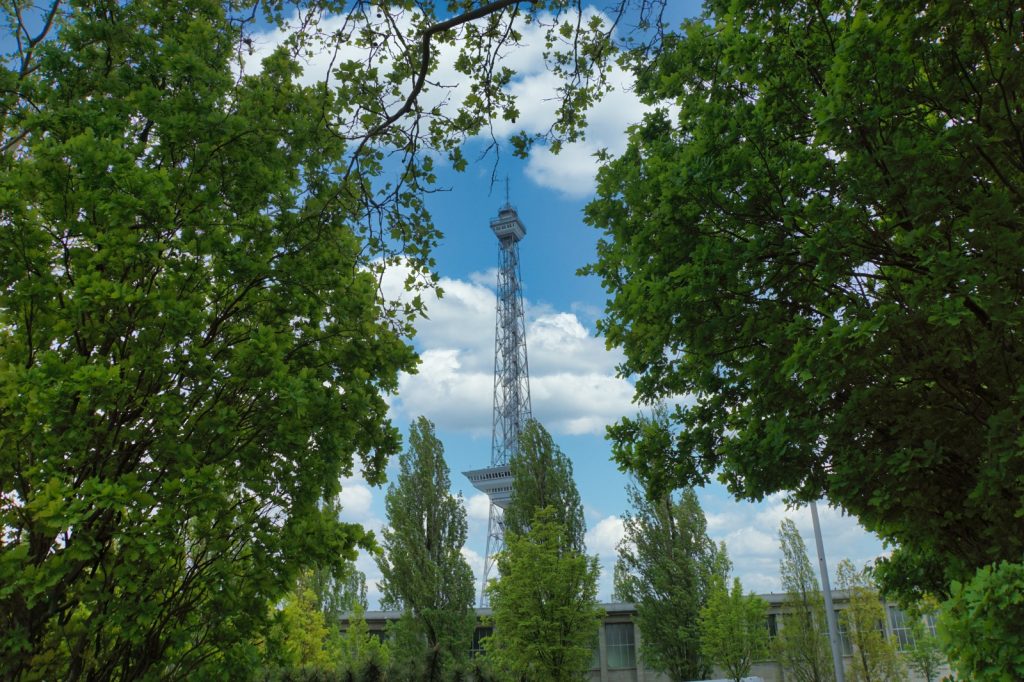
The Berlin Radio Tower is 150 meters high. In stronger winds, the top of the tower sways almost 40 centimeters.
At a height of 126 meters, there is an observation deck that can be reached by elevator. My last visit up there was unfortunately quite a long time ago. But I can remember very well that the view was sensational.
If you like to dine in style at a lofty height, you can dine in the radio tower restaurant at a height of 55 meters and enjoy the view over the city. The special of the restaurant, you sit in an original Art Nouveau interior and enjoy the nostalgic charm of the twenties.
Opening hours:
Viewing platform
Tuesday – Friday: 14-22 h
Saturday, Sunday: 11-22 h
Monday: closed
Attention. There may be closures due to weather conditions.
Admission fees:
Viewing platform
Adults: 6,-€
Restaurant:
Adults: 3,-€
During trade fairs or events, access may be restricted or only possible in conjunction with a trade fair ticket.
In summer there are regular maintenance works, which make the access to the tower not possible.
Exhibition Grounds Berlin
After the view high up to the radio tower the way leads me further along the fairground.

The North Entrance of the exhibition grounds is located at Hammarskjöldplatz on Masurenallee. The North Entrance, the so-called Hall of Honor, dates from 1936 and was built by Ermisch. The hall is quite imposing from the outside with its almost 42 meters in length, 21.4 meters in width and almost 32 meters in height. The steel skeleton structure is clad in natural sandstone and has high rectangular windows. To the right and left of the Hall of Honor are other exhibition halls.
When you stand in the hall during events, you don’t realize how big this space really is.
This place has not only seen plenty of history, but is still the venue for trade fairs, gala events and receptions.
House of broadcasting
Directly opposite the main entrance to the exhibition halls is the Haus des Rundfunks. It is the first broadcasting building in Europe and was built according to plans by Hans Poelzig in 1931. It is one of the most beautiful examples of modern architecture in the city. I am always impressed by the facade made of black clinker brick and red-brown ceramic tiles.
From 1931, Funk-Stunde Berlin, Deutsche Welle GmbH (from 1933: Deutschlandsender) and the Reichs-Rundfunk-Gesellschaft broadcast from here. The first German television program was also broadcast from here. From 1939 to 1945, the Haus des Rundfunks was the headquarters of the Greater German Broadcasting Corporation.
At the beginning of May 1945, the Red Army occupied the building, which had been spared from the war, and initially broadcast the first calls and news. By mid-May, normal broadcasting operations could be resumed.

Although the building was located in the British sector after the division of the city into the four sectors, the Soviets used the facility until 1950. During this time, they secretly dismantled the technical facilities and moved them to their sector.
It was not until 1956 that the Soviet military command handed over to the Berlin Senate. The building had to be renovated and equipped with new technology. In 1957, Sender Freies Berlin (SFB) was able to start broadcasting its program. In 2003, SFB merged with Ostdeutscher Rundfunk Brandenburg to form Rundfunk Berlin-Brandenburg (rbb).
To this day, the building offers ideal conditions for radio broadcasting. The offices and editorial offices face the outside of the building. These form almost a triangle around the studio complexes, which are located inside and are thus almost completely sealed off from street noise. The large broadcasting hall went into operation as early as 1931. Even today, you are transported back to 1959 when you enter it. The wall paneling is still preserved and the 1081 folding seats also date from that time. They were made so that even when the hall is empty, the sound is almost the same as when the chairs are full. When you enter the Small Broadcasting Hall, you are transported even further back in time. It is still in the condition it was in 1931.

Right next to the Haus des Rundfunks stands the newer extension from 1961-71. The cubic structure gives the reinforced concrete building a characteristic look and makes it an unmistakable building in Berlin.
During my little walk in the direction of Theodor-Heuss-Platz I met an old acquaintance in front of the building – the Sandman! Here, however, it sits alone and well protected from viruses on a bench and his friends can be found in the immediate vicinity, as in Erfurt.

Theodor-Heuss-Platz
My walk ended at Theodor-Heuss-Platz.
The square, created in 1904, has had quite a few names throughout history:
1904-1933 Reichskanzlerplatz
1933-1947 Adolf Hitler Square
1947-1963 Reichskanlzer Square
1963 until today Theodor-Heuss-Platz, named after the first president of Germany
The square was initially undeveloped in 1904, but there was already at that time at the northeast end the entrance to the subway station. In Speer’s plans, the square was to be the western end of the east-west axis, surrounded by monumental buildings and with a monument to Mussolini. The buildings never materialized.

If you stand on the Theodor-Heuss-Platz you can see in the direction of the west the straight Heerstraße and in the direction of the east the Kaiserdamm, Bismarckstraße, Straße des 17.Juni with Siegessäule and Brandenburger Tor down.
On the square is a striking fountain sculpture in the form of a blue obelisk, but I have never really liked.
For me as a child, a main attraction has always been the “Eternal Flame” on Theodor-Heuss-Platz. The memorial was erected for the victims of flight and expulsion in 1955. Ever since I can remember, a flame has burned here and every year on August 31st, on the Day of the Homeland, a wreath is laid.


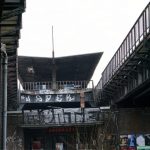





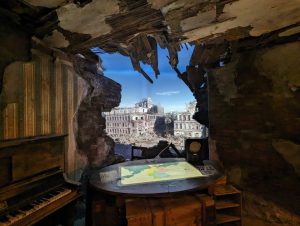






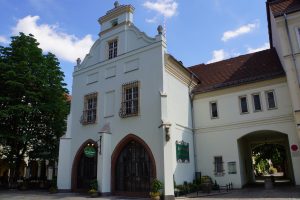

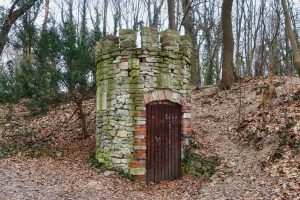
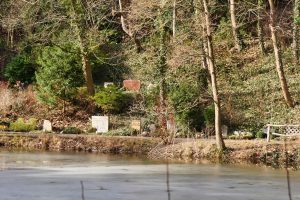
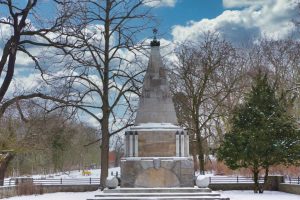





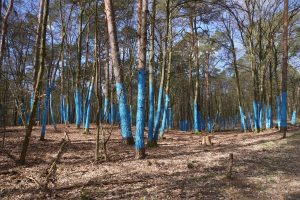




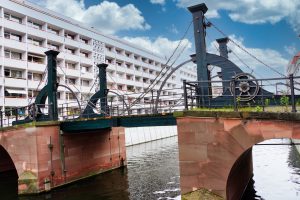
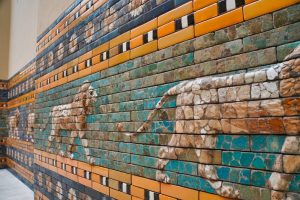



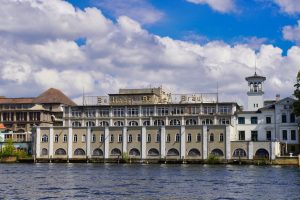









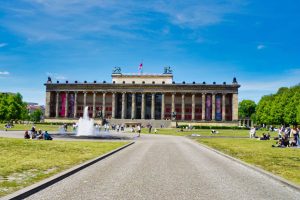





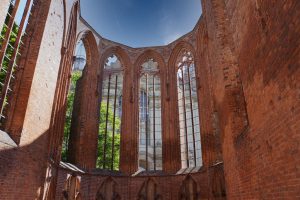


















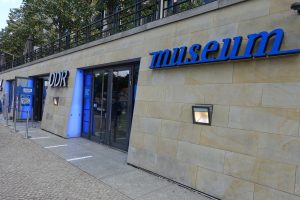





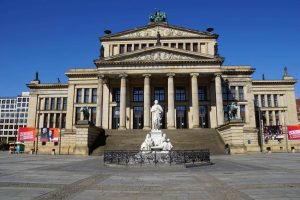







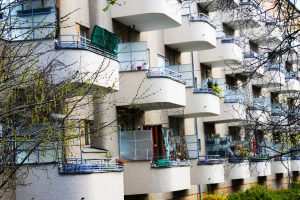





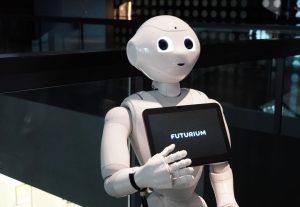




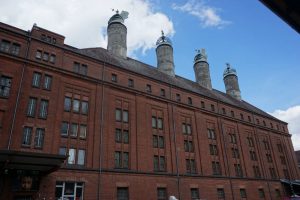





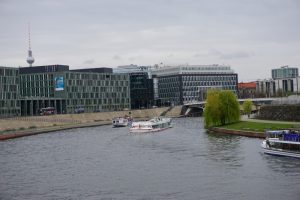
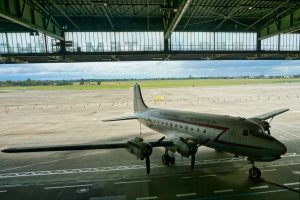








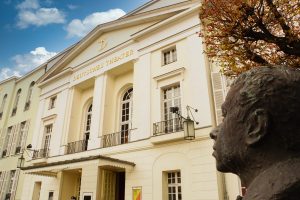


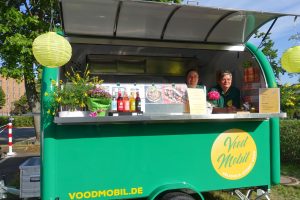















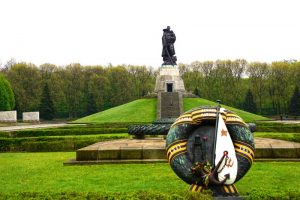














Leave a Reply